
01. Tomb of Ishikawa Masamochi
Metropolitan Historic Site
Kaya-dera Temple, 3 chome 22-9, Kuramae
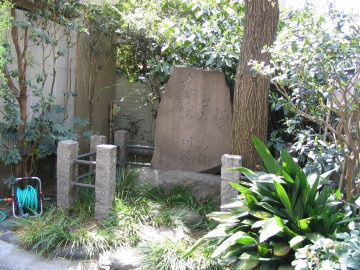
02. Monument to Karai Senryu Inscribed with His Poem
Ryuho-ji Temple, 4 chome 36-7, Kuramae
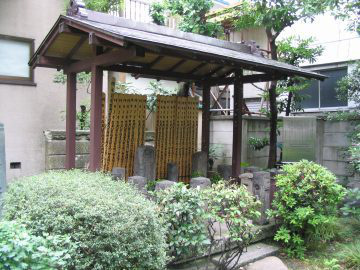
03. Tomb of Karai Senryu I
Metropolitan Historic Site
Ryuho-ji Temple, 4 chome 36-7, Kuramae
Karai Hachiemon, founder of Senryu (humorous seventeen-syllable poetry) was born in 1718. Besides being the head of a village, he enjoyed a good reputation as a Senryu poet for 33 years. He passed away in 1790 at the age of 73. His pen name was Senryu and this humorous seventeen-syllable poetry has been called "Senryu" since the Meiji Period.
The left-hand tombstone is for Senryu I. On the surface the names of Senryu I and his wife and Senryu Ⅲ and his wife are engraved from right to left.
On the right-hand tombstone, the names of Senryu II and his wife were engraved but they are now illegible due to erosion.
Behind the tomb site to the right of the tomb stone of Senryu I, a centennial monument was set up for him in 1889.
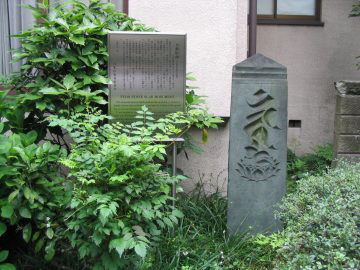
04. Fudo Stone Slam Monument
Taito City Tangible Cultural Properties
Ryuho-ji Temple, 4 chome 36-7, Kuramae
This memorial stone or tablet -standing like an obelisk- is 155.8 cm in height, 44.5cm wide at the bottom and tapering to 39cm at the top and has an average thickness of about 5 cm.
It was erected in 1293 and it is one of the most traditional ones in Taito City. The inscription at the bottom tells us that it was commissioned by a man as an act of warship for the peace of the soul of his late father. The large figure chiseled into the center is a Sanskrit character symbolizing Fudo-Myo-o (Acala).
It was registered as an important cultural asset in 1990 in the book of Cultural Assets of Taito City.
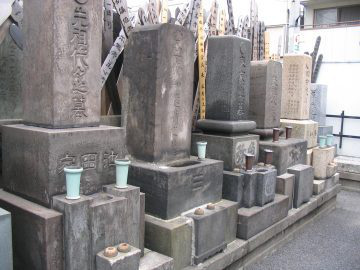
05. Tomb of Mishima Masayuki
Metropolitan Historic Site
Jyonen-ji Temple, 4 chome 18-11, Kuramae
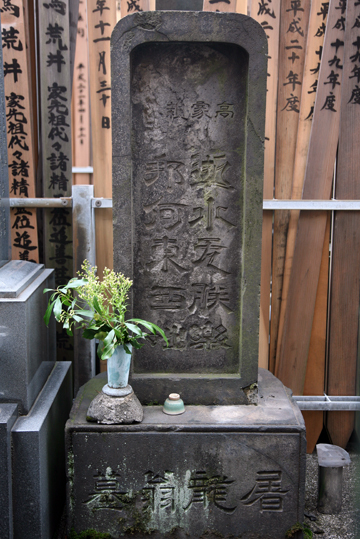
06. Tomb of Kou Sukoku
Horin-ji Temple, 4 chome 15-2, Kuramae
Kou Sukoku was born in 1730. He was a painter in the middle of the Edo Period and excellent at pictures of famous samurai in combat. Among all, the picture called "Extermination of a chimera", which is now kept at Senso-ji Temple, is considered one of the most representatives of his work. It depicts a legend from the Heike Monogatari (Story of Heike Family) about a warlord called Minamoto Yorimasa who exterminated a chimera.
Kou Sukoku passed away at the age of 75 years old in August of 1804 and was buried in this temple.
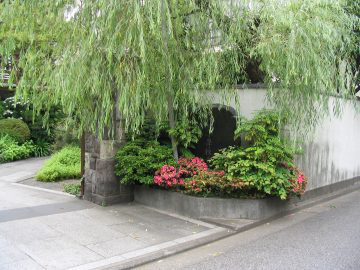
07. Birthplace of Ikuei Primary School
Saifuku-ji Temple, 4 chome 16-16, Kuramae
In March of 1869 the Japanese government started revolutionizing the Japanese education system. In the following March it opened 6 primary schools in Tokyo. One of them was opened here in the precincts of Saifuku-ji Temple and called the 4th school. This is the birthplace of one of the earliest public primary schools in Tokyo.
The 4th school existed here until the middle of April in 1874. In August in 1877 it was renamed Ikuei primary school and in October 1885 this school was moved to the present site (8-26, 2-chome, Asakusabashi).
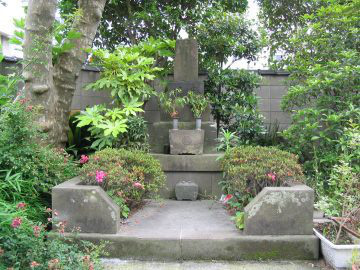
08. Tomb of Katsukawa Syunsho
Metropolitan Historic Site
Saifuku-ji Temple, 4 chome 16-16, Kuramae
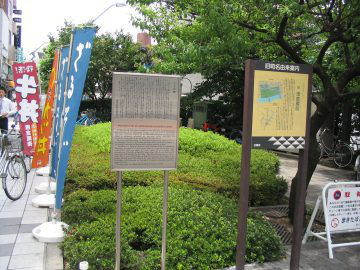
09. The Ruins of an Astronomical Observatory
3 chome, Asakusabashi
On the west side of this spot, covering the entire area in 21, 22, 23, 24 and some area of 19, 25, 26 of Asakusabashi 3-chome, there used to be an astronomical observatory which was a facility for the Edo feudal government to practice such things as astronomy, calendrical art, surveying, editing topography, and translating foreign books in the second half of the 18th century. The astronomical observatory was moved from Ushigome and rebuilt in 1782. It was originally a facility of the Tenmon-gata public office, which made Calendars. It was needed for astronomical observations to produce accurate calendars.
According to a historical document called “Shitendai-no-ki”, the astronomical observatory was about a 5.5 square meters (about 6 yd. sq.) and was built on an artificial hill which was approx. 9.3 meters (about 31 ft.) in height. The circumference of the hill was about 93.6 meters (about 103 yd.) and there were 43 stone steps with handrails on both sides. The Katsushika Hokusai (an Ukiyo-e' artist) drew a scene called Torigoe-no-Fuji (Mt. Fuji seen from Torigoe) in his “Fugaku Hyakkei” series (100 scenes of Mt. Fuji), showing Asakusa Astronomical Observatory with Konten-gi, an instrument to measure astronomical positions, against Mt. Fuji.
This observatory was abolished by the Meiji Government in 1869.
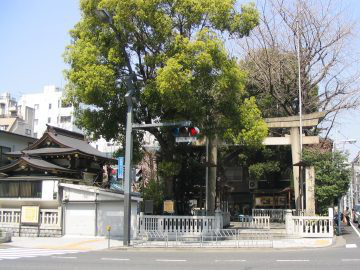
10. Torikoe Shrine
2 chome 4-1, Torigoe
The Torikoe Shrine, founded in about 651, is an establishment dedicated to Yamato-takeru-no-mikoto. Amenokoyane-no-mikoto and Tokugawa leyasu. Its festival is held on the Sunday near June 9, and the passage of a gigantic portable shrine, which is called a 1,000-kan (quite heavy) portable shrine, attracts many people as the Night Festival of Torikoe.
The Tondo-yaki held on January 8 is an event in which New Year decorations, the preceding year's charms, etc. are gathered and burned in the compounds of the shrine.
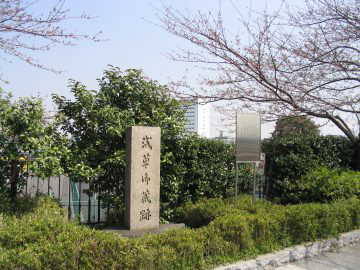
11. Monument for the Trace of Asakura Okura Warehouse
2 chome 1, Kuramae
Asakusa warehouse was used for storing and keeping rice and so forth that was submitted and paid as tax from land scattered across the country which was directly controlled by the Tokugawa Government. Rice in the Asakusa warehouse was supplied mainly to the families of Tokugawa's samurais and was under the control of the chief treasurer. The warehouse was built in 1620 by excavating the hill of the Asakusa Torikoe Shrine and by filling the ground with earth at the present place.
The front side of the Asakusa warehouse was called the "warehouse front" and there were many stores of rice wholesalers, weight checkers, moneylenders, etc. on this front side.
The town name Kuramae was born in 1934 from the word OKURA front.

12. Shubi no Matsu
1 chome 3, Kuramae
About 100 meters (about 330 ft.) down the Sumida River from this monument, on the riverbank, there used to be famous Matsu tree Shubi no Matsu. (pine tree of success).
The origin of the name of the pine tree Shubi is not exactly clear but here are some explanations:
1. It was named because a man, a shogun's retainer, “successfully” rode a horse across the flooded Sumida River from the pine tree to the other bank in the presence of the third shogun, Iemitsu.
2. Men of the world talked together under this pine tree about their “Shubi (success)” at Yoshiwara when they crossed the Sumida River.
3. Laver (edible seaweed) used to be harvested here using “hibi” (long sticks to collect laver) stuck in the river, and the pronunciation of “hibi” was corrupted into “shubi”.
The first “Shubi no Matsu” was blown down during the An'ei Period (1772-1780), its successor died during the Ansei Period (1854-1859), the third pine died at the end of the Meiji Period (around 1910), and their successors were entirely destroyed by the fires of the Kanto Great Earthquake of 1923 and the World War Ⅱ. In December 1962, members of Asakusa-nanbu Association of Commerce, Industry and Tourism regretted the loss of these pines and built a monument close to this bridge in cooperation with the local people. The present pine monument is said to be the seventh tree.

13. Monument of Asakura Public Library
Sakaki Shrine, 1 chome 4-3, Kuramae
In July 1874, the Asakusa public library was established, and opened the following year for private and public use.
While it was open, the library was said to have anywhere between 110,000 to 130,000 books written in Japanese, Chinese and Western Languages. These books are now housed in the National official document Cabinet library, National Diet Library and Tokyo National Museum Library. All the books that were in the Asakusa library have the stamp of the Asakusa library, that was hand stamped by one of the Cabinet ministers of the day, Sanjo Sanetomi.
The library closed in May 1881 and in the following year, it became a part of the Tokyo Higher Technical School, now known as the Tokyo Institute of Technology. In 1924 the Tokyo Higher Technical School moved to its current position in Ookayama in Meguro City.
In 1928, the current Sakaki shrine was built. Later in November 1940 the current monument (approx. 4 meters) to mark the place of the previous Asakusa library as a cultural and educational area was built.

14. The Ruins of the Kuramae Industrial School
Sakaki Shrine, 1 chome 4-3, Kuramae
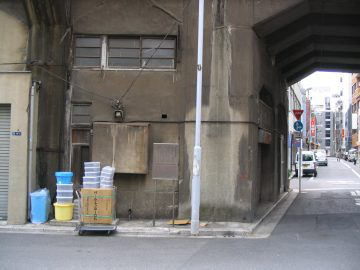
15. Birthplace of Hayami Gyoshu
1 chome 19, Yanagibashi
Hayami Gyoshu was born on August 2, 1894. From an early age his goal in life was to become a painter, so he and entered Angado Art School run by Matsumoto Fuko. He submitted a work for exhibition when he was 16 years old. The work, entitled "Murohogi-no-En", which was exhibited the following year was highly acclaimed and purchased subsequently by the Imperial Household Agency. In the 6th year of the Taisho Period, he exhibited his famous painting entitled “Rakugai Rokudai”. He passed away in 1935, when he was only 40 years old, at a great loss to the Japanese art. Some of his works are designated as Important National Cultural Assets.

16. Yanagibashi
1 chome 1-1, Yanagibashi
The Yanagibashi Bridge was first built in 1698, the present bridge was erected in 1929. There are several explanations for the origin of the name, Yanagi (it means willow) Bridge. One explanation is that willow trees stood at the base of bridge. In the 19th century this neighborhood was a bustling red-light district known in Japanese as the geisha world. Yanagibashi was the subject of art and literature at that time.















